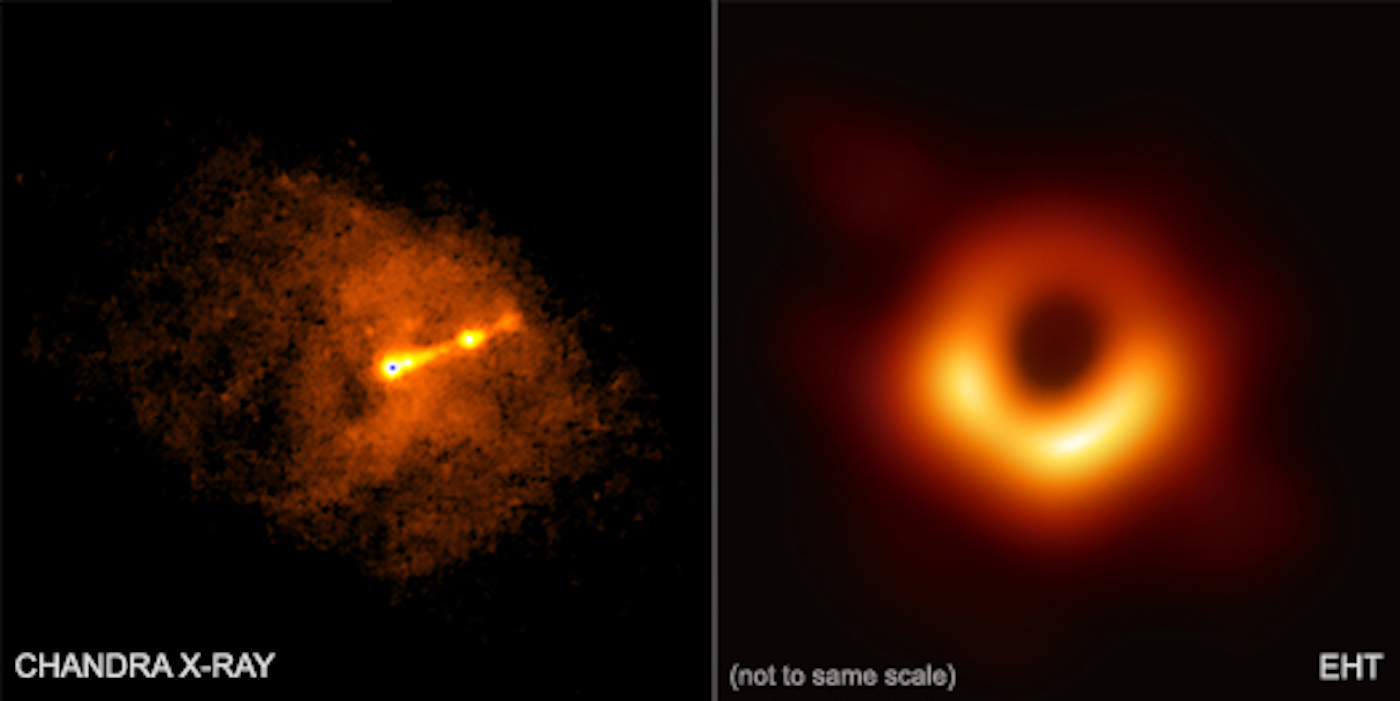In a historic feat by @EHTelescope & @NSF, a black hole image has been captured for the 1st time. Several of our missions observed the same black hole using different light wavelengths and collected data to understand the black hole's environment. Details: https://t.co/WOjLdY76ve pic.twitter.com/4PhH1bfHxc
— NASA (@NASA) April 10, 2019
Reprinted from Chandra X-Ray Observatory
There are a lot of clichés that get thrown around when talking about big scientific discoveries. Words like “breakthrough” or “game changing” are often used. They grab people’s attention, but it’s fairly rare that they apply.
Today’s announcement of the first image ever taken of a black hole (more precisely, of its shadow) truly rises up to that standard.
By definition, nothing not even light, can escape the gravitational grasp of a black hole. This, however, is only true if you get too close, and the boundary between what can and cannot get away is called the event horizon.
This dark portrait of the event horizon was obtained of the supermassive black hole in the center of the galaxy Messier 87 (M87 for short) by the Event Horizon Telescope (EHT), an international collaboration whose support includes the National Science Foundation. This achievement is certainly a breakthrough, and we at NASA’s Chandra X-ray Observatory congratulate and applaud the hundreds of scientists, engineers, and others who worked on the Event Horizon Telescope to obtain this extraordinary result.
As is well documented in today’s announcement, it took a remarkable effort and coordination from scientists and organizations around the world to even have a chance to make this happen. The result being heralded stems from an observing campaign during April 2017, when this global network of radio dishes observed M87 together.
While Chandra can’t see the shadow itself, its field of view is much larger than the EHT’s, so Chandra can view the full length of the jet of high-energy particles launched by the intense gravitational and magnetic fields around the black hole. This jet extends more than 1,000 light years from the center of the galaxy.
LOOK: In Historic First, Scientists Have Landed Rovers On an Asteroid and They’re Transmitting Photos
As for the investigation of the black hole in M87, Chandra has been on the case for quite some time. M87 is an elliptical galaxy in the Virgo galaxy cluster, about 60 million light years away from Earth. For years, scientists have known that a supermassive black hole weighing several billion times the mass of the Sun sits at the center of M87.
Surrounding the elliptical galaxy is a reservoir of multimillion-degree gas, which glows brightly in X-ray light. Chandra’s studies of this hot gas have given astronomers insight into the behavior and properties of the giant black hole. For example, astronomers have used Chandra data to discover ripples in the hot gas, which provide evidence for repeated outbursts from the black hole roughly every 6 million years or so.
What does today's black hole image news mean? Our @ChandraXRay Observatory team puts it into perspective and shares just what a difficult feat it was for @NSF and @EHTelescope to obtain the new black hole image. Read more about #EHTBlackHole: https://t.co/s9xoxt8l3S pic.twitter.com/TQD8HSdbGG
— NASA (@NASA) April 10, 2019
Scientists will be poring over the new EHT image and the papers that are being published in connection with this result for weeks, months, and even years to come. As they do, they will continue to pull in every resource they can — including famed black hole hunter, the Chandra X-ray Observatory — to learn as much as they can about these exotic and fascinating objects.
For more live-streamed updates on the groundbreaking discovery from the National Science Foundation, click here.
(WATCH the video below)
Be Sure And Share The Groundbreaking Cosmic News With Your Friends On Social Media…





















This story made me weep. How insignificant we are compared to the magnificence and scope of the Universe! And yet at the same time to those of us standing on this planet, each little life feels so big and so significant.